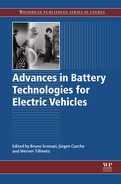Table of Contents
1.1 Electric mobility: mobility of the future
1.2 Overview of different electric propulsion systems
1.3 Advantages and disadvantages of electric vehicles
1.4 Applications in the field of electric road and off-road vehicles
2: Carbon dioxide and consumption reduction through electric vehicles
2.2 Energy consumption and CO2 emissions of vehicle production
2.3 Energy consumption of electric vehicles
2.4 Life-cycle energy consumption and CO2 emissions compared
2.5 Potential interactions of electric vehicles with power generation: a case study from Germany
3: The market for battery electric vehicles
3.3 Market forces and barriers
4: Battery parameters for hybrid electric vehicles
4.2 Battery parameters for HEV applications
4.3 Overview of lithium-ion batteries and supercapacitors for use in HEVs
4.4 Limits to and potential future developments of lithium-ion batteries and supercapacitors
4.5 On road transportation in the future
Part Two: Types of battery for electric vehicles
5: Lead–acid batteries for hybrid electric vehicles and battery electric vehicles
5.2 Technical description of the LAB
5.3 Environmental and safety aspects of LABs
5.4 Different types of automotive LABs
5.5 Advantages and disadvantages of LABs in HEV applications: general
5.6 Potential future developments in LABs and HEVs
5.8 Sources of further information
6.2 Technical description of NiMH and NiZn batteries
6.3 Electrical performance, lifetime, and cost of NiMH and NiZn batteries
6.4 Advantages and disadvantages of NiMH and NiZn batteries in HEVs and battery electric vehicles
6.5 Design issues of NiMH and NiZn batteries in HEVs and battery electric vehicles
6.6 Most suitable applications of NiMH and NiZn batteries
6.7 Environmental and safety issues with NiMH and NiZn batteries
6.8 Potential future developments in NiMH and NiZn batteries for HEVs and battery electric vehicles
6.9 Market forces and future trends
7: Post-lithium-ion battery chemistries for hybrid electric vehicles and battery electric vehicles
7.1 The dawn of batteries succeeding lithium-ion
7.5 Conversion reaction materials
7.6 Sodium-ion and sodium-air batteries
7.7 Multivalent metals: magnesium battery
8: Lithium-ion batteries for hybrid electric vehicles and battery electric vehicles
8.6 Future developments in cell chemistries
8.7 Future developments in Li-ion battery packs
8.8 Market forces and future trends
9: High-performance electrode materials for lithium-ion batteries for electric vehicles
9.3 Anode (high-performance anode materials for lithium-Ion automotive batteries)
Part Three: Battery design and performance
10: Design of high-voltage battery packs for electric vehicles
10.2 Components of HV battery packs
10.3 Requirements of HV battery packs
10.5 Sources of further information
11: High-voltage battery management systems (BMS) for electric vehicles
11.6 Sources of further information
12.2 Battery cell balancing overview
12.6 Sources of further information
13: Thermal management of batteries for electric vehicles
13.2 Motivation for battery thermal management
13.3 Heat sources, sinks, and thermal balance
13.4 Design aspects of thermal management systems
13.5 Exemplary design calculations
13.6 Technologies in comparison
13.9 Sources of further information
14: Aging of lithium-ion batteries for electric vehicles
14.3 Aging mechanisms and root causes
14.4 Cell design and cell integrity
14.10 Extension of battery lifetime
15: Repurposing of batteries from electric vehicles
15.3 Advantages of battery repurposing
15.5 Performance requirements for various grid-storage applications
15.7 Market forces and future trends
15.8 Additional sources of information
16: Computer simulation for battery design and lifetime prediction
16.3 Essentials of the multiscale modeling approach
Part Four: Infrastructure and standards
17: Electric road vehicle battery charging systems and infrastructure
17.2 Mobility behavior and charging infrastructure
17.3 Classification of battery charging systems and infrastructure
17.4 Advantages and disadvantages of the solutions for battery charging systems and infrastructure
17.5 Market forces and future trends
17.6 Sources of further information
18: Standards for electric vehicle batteries and associated testing procedures
18.2 Standards for electric vehicle (EV) batteries
18.3 Testing procedures for EV batteries
18.4 Future trends in battery testing
18.5 Sources of further information
19.2 Objective of the legal requirements
19.4 Work in the informal working group
19.5 Content of the legal requirements
Appendix: abbreviations and symbols
